
MAY CONTAIN NUTS

Search Shorpy
SHORPY ART

Framed or unframed, desk size to sofa size, printed by us in Arizona and Alabama since 2007. Explore now.
Join and Share
Ad-Free Shorpy
Shorpy is funded by you. Patreon contributors get an ad-free experience.
Learn more.

Recent comments
- Baldwin 62303
- Baldwin VO-1000
- Cold
- No expense spared
- Tough Guys
- Lost in Toyland
- And without gloves
- If I were a blindfolded time traveler
- Smoke Consumer Also Cooks
- Oh that stove!
- Possibly still there?
- What?!?
- $100 Reward
- Freeze Frame
- Texas Flyer wanted
- Just a Year Too Soon
- WWII -- Replacing men with women at the railroad crossing.
- Yes, Icing
- You kids drive me nuts!
- NOT An Easy Job
- I wonder
- Just add window boxes
- Icing Platform?
- Indiana Harbor Belt abides
- Freezing haze
- Corrections (for those who care)
- C&NW at Nelson
- Fallen Flags
- A dangerous job made worse
- Water Stop
Member Photos
The Shorpy
Print Emporium
Print Emporium
Search Shorpy
Search results -- 30 results per page
- Andy's Cafe: 1941
- ... Interstate 75.
Interestingly, Shorpy favorite John Vachon seems to have taken a picture of this place in November 1938 .
... Posted by Dave - 06/11/2023 - 4:31pm -
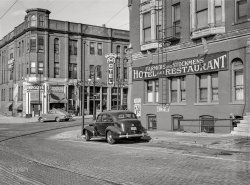
- Double Duty: 1942
- ... Accommodations at the Wisdom Hotel." Acetate negative by John Vachon for the Office of War Information. View full size.
Two things ... Posted by Dave - 10/26/2021 - 1:02pm -
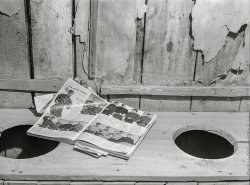
- Recovering Nicely: 1953
- ... 1953. Marilyn Monroe with Look magazine photographer John Vachon in Alberta, Canada, after she hurt her ankle filming River of No ... Posted by Dave - 08/02/2013 - 11:00am -
![Recovering Nicely: 1953 1953. Marilyn Monroe with Look magazine photographer John Vachon in Alberta, Canada, after she hurt her ankle filming River of No Return. View full size.
Architectural themeFor Alberta hospitals c. 1953? Dreary. But the hospital "gown" is aesthetically quite OK.
Two WordsHubba Hubba !
Tough JobPoor John Vachon. Travel up to a beautiful part of Canada, hang around and photograph some young actress named Marilyn Monroe. Nice work if you can get it. I would have taken this gig, but was only 1 year old at the time. Where's a time machine when you need it?
SplendidRecovery, I must say.
Axiom Proven Once AgainAs it is often said when a picture of the darling Marilyn is posted ... She never took a bad picture ...
The lovely smile, beautiful hair and a natural body shape that still makes men drool 51 years after her death.
Is that a tan line ...... on her leg?
[See this photo. -tterrace]
(John Vachon, Marilyn Monroe, Pretty Girls)](https://www.shorpy.com/files/images/SHORPY_00210u.thumbnail.jpg)
- Arkansas Pickers: 1940
- ... family before moving on to new work location." Photo by John Vachon for the Farm Security Administration. View full size.
OUCH! ... Posted by Dave - 12/09/2019 - 10:43am -
![Arkansas Pickers: 1940 July 1940. Berrien County, Michigan. "Migrant agricultural workers -- 'fruit tramps' harvesting cherries and strawberries. Miserable housing in company shacks, cabins, tents, trucks, abandoned farm buildings, small children in fields with parents. Migrant mother from Arkansas taking a picture of the family before moving on to new work location." Photo by John Vachon for the Farm Security Administration. View full size.
OUCH!"Fruit tramps"?
Harsh!
Somewhere ...Somewhere, in some hope chest, closet, thrift store, or landfill - is an 80 year old image from a Kodak Brownie of John Vachon sitting on the roof of a shed taking this image.
Big Sis?Far be it from me to question Mr. Vachon who was obviously there on the spot in 1940, but... the young lady holding the camera hardly looks old enough to be a mom. Could it be that 'mom' is whose legs are visible off to the left holding the baby while big sister tries to snap a photo of her brothers and their dog?
[Once upon a time it was not uncommon to see women in their twenties with little kids who were their actual children! - Dave]
(The Gallery, Agriculture, Dogs, John Vachon, Kids)](https://www.shorpy.com/files/images/SHORPY-8c17741a.thumbnail.jpg)
- Whiskey Wine Brandy Gin: 1939
- ... store in Gateway District, Minneapolis." 35mm negative by John Vachon for the Farm Security Administration. View full size.
Motorola ... Posted by Dave - 09/14/2011 - 6:13pm -
![Whiskey Wine Brandy Gin: 1939 September 1939. "Liquor store in Gateway District, Minneapolis." 35mm negative by John Vachon for the Farm Security Administration. View full size.
MotorolaThe antenna:
re: MotorolaThank you! I posted the photos on a classic car forum and someone speculated that it might be a Motorola, but I wasn't able to find anything on it myself.
32 Washington AvenueThe Minnesota Historical Society has Hughes Drugs at 32 Washington Avenue South. It was housed in a block of buildings which contained several addresses on the east side of Washington.
[The address here is, as we can see, 38. Stores move, or can have more than one location. - Dave]
MercBrand spankin' new '39 Mercury sitting front and center. First year for the new marque. 1939-2011 RIP
September 1939It was the worst month in modern history of my country (Poland). However, nice to see such a pretty place, at the same time, but other side of the ocean. And this car, I always thaught, that body is postwar style. Not just a while before the WW II.
Merc gizmoSo what is this? I speculated that it was a flashy antenna, but a cursory Google search didn't come up with anything like it. Merely decorative? Whatever, I love it.
"Chicago Service"What is it?
Blimey!Whiskey, wine, brandy, trusses, rubber goods AND cut-price drugs?
Drugs, Booze ...What! No gambling? At least you can buy a truss. Today this enterprise would be run by the Government.
HandsomeI can see where my PV 544 got his good looks. This could be the Toad's grandfather.
HmmI wonder what they sell at this store? I'm kidding! Great photo -- I especially like seeing the film perforations.
Drugs, trusses, rubber goodsOne-stop shopping!
LettersSome signpainter was in business for a while after that job!
Chicago ServiceDoes the cafe feature surly waiters? Or is that called "New York service"?
Chicago ServiceThe regular daily train between Minneapolis and Chicago ran to a station just along here, which may be the origin of the cafeteria's name.
Merc gizmo foundI finally found a match for the "gizmo" on the Mercury's roof. It is indeed a radio antenna, and here's another one on a 1939 Lincoln Zephyr. Maybe it was a Ford product. What an incredibly cool thing.
[I just knew TT would find this. Several commenters opined the gizmo was a "scratch on the negative" (which would have been black lines, not white) or part of the sign behind the car. - Dave]
Positively Second StreetAs best as I can tell, these addresses were on the northeast side of South Second Street (a block south of the Great Northern Railway station, which was at the foot of Hennepin Avenue). Vachon, a St. Paul native, would have known the area well. In the 1950s, as scorched-earth urban renewal was on its way for the Gateway, young University of Minnesota sociology students, led by Theodore Caplow, conducted groundbreaking field research in this area on the thousands who called the Gateway's cage hotels, missions and alleys their home. This spot is now on Gateway Greenway, a one-block auto-free path.
Motorola AntennaHere's another, more elaborate version of the antenna on a '38 Plymouth in a photo taken in summer 2010.
IgnoredThe antennaless car behind the Mercury is a 1939 Chevrolet that has an accessory hood ornament.
This was the last year that you could obtain a rear mounted spare tire on a Chevy until the availability of "continental kits" in the 1950s. Chevrolet discontinued these last car models without modern trunks early in the model year.
(The Gallery, Cars, Trucks, Buses, John Vachon, Minneapolis-St. Paul)](https://www.shorpy.com/files/images/8a04729a.thumbnail.jpg)
- The Farmer's Daughter
- ... Nebraska. View full size. 35mm nitrate negative by John Vachon for the Farm Security Administration.
I think… …I heard a ... Posted by Dave - 12/11/2007 - 9:38pm -
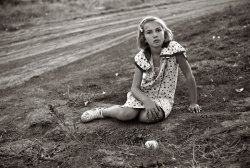
- The Corn Is Yellow: 1942
- ... from wagon through feed store window." 35mm Kodachrome by John Vachon for the Office of War Information. View full size.
Wide ranging ... Posted by Dave - 06/30/2022 - 1:07pm -
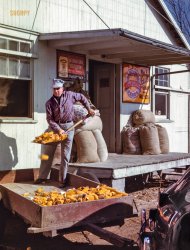
- Shacktown: 1940
- ... chickens. View full size. 35mm nitrate negative by John Vachon for the FSA.
Shacktown: 1940 Does anyone know if the people in ... Posted by Dave - 09/09/2011 - 10:03am -
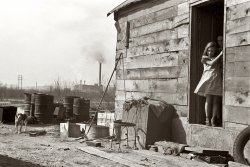
- Air Castle: 1942
- ... Abandoned roadhouse." Medium format acetate negative by John Vachon for the Office of War Information. View full size.
Seeing Bates ... Posted by Dave - 08/14/2021 - 2:19pm -
![Air Castle: 1942 February 1942. "Bates County relocation project, Missouri. Abandoned roadhouse." Medium format acetate negative by John Vachon for the Office of War Information. View full size.
Seeing Bates CountyI wonder if John Vachon stayed at the Bates Motel.
I wonder Do you think they may have sold soft drinks here?
LocationThis property is located in Newton County and was condemned by the Fed Gov for the construction of Camp Crowder. All of the Displaced Indigenous Persons were relocated to Bates County.
I have to agree that the ditch/creek looks odd being there. This is a 'Roadhouse' so the road is no doubt to the left. Where's the driveway to the building? The walkway to same? I think the building has been empty for a while and the prep work for the drainage and road improvement has begun a bit earlier. (the grass is growing back)
[The driveway to the parking lot would be out of frame to the right. - Dave]
But the road!?The roadhouse looks empty but shuttered and closed. But that road? I have never seen one like it. Almost a "sunken" road as you may see in England or the continent. Long periods of foot traffic not cars. Why would it look like that?
[That's a ditch, and I'd be happy to drive! - Dave]
(The Gallery, Eateries & Bars, John Vachon, Rural America)](https://www.shorpy.com/files/images/SHORPY-8c20757a.thumbnail.jpg)
- Raised on Radio: 1942
- ... ordnance plant." Medium format acetate negative by John Vachon for the Office of War Information. View full size.
Radio ID ... Posted by Dave - 08/13/2021 - 5:50pm -
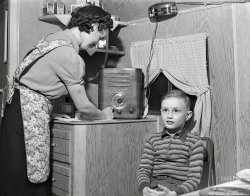
- Good American Food: 1942
- ... the "homey" Palace Cafe. Medium format acetate negative by John Vachon for the Farm Security Administration. View full size.
Now, good ... Posted by Dave - 02/19/2022 - 12:51pm -
![Good American Food: 1942 May 1942. "Grand Island, Nebraska." Home of the "homey" Palace Cafe. Medium format acetate negative by John Vachon for the Farm Security Administration. View full size.
Now, good ol' American marketing.Lots of building still there, but that monster in the center is gone.
On the horns of a dilemmaI'm drawn to the courteous service and homey atmosphere at the New Palace -- not to mention the modern rest rooms and reasonable prices -- but then at Caredis I am welcome "just as I am" and am invited to inspect their ... something. Whatever it is, I'd like to check it out. Since I'm so welcome.
In other news, the woman walking away from the camera on the far right-hand side of the photo instantly struck me as resembling Loretta, the female assassin who walks towards Robert Redford a/k/a Johnny Hooker in the alleyway in The Sting. Loretta wasn't wearing a headscarf, but still. Gives me chills just thinking about it.
Both the Palace Cafe and Caredis Cafehave large signs directed at "tourists" ... what made Grand Island, Nebraska a tourist hot spot in 1942?
What tourists?Both cafes seem to be catering to tourists. I wonder how big the hospitality business was in Grand Island 5 months into WWII. The Palace Cafe looks like it was a movie house in a past life, what with that sidewalk canopy/marquee and the vertical signage.
Superb (Again)Vachon wasn't one of the photographers I learned about back when that was my field of study. But I'm going to make up for lost time. These Shorpy sharings induced me to buy a couple of his books. I eagerly await their arrival.
Rare bird sighting!Photographer Vachon, perhaps by chance, captured the ultra-rare auto seen here in the closest parking space on the right-hand side.
The famed Borden Dairy firm decided, in the mid 1920s, to branch into another industry, and thus was born Borden's Eagle Automobiles, Inc. There was just one model, shown here: the Borden's Eagle Condensed Special.
Unfortunately, the demand for such a truncated car just wasn't enough to justify the investment and the venture was unsuccessful, folding after just two years.
MystifiedWhat would have been un-American food and service in the middle of 1942 in the middle of Nebraska? Somehow I doubt that the Caredis Cafe next door is offering moussaka instead of mac and cheese, bifteki instead of burgers or baklava instead of apple pie. But the cooled air and the 24/7 might be a thorn in the side of the New Palace Cafe.
[In the 1920s and '30s, any American restaurant with "Palace" in its name was very likely a chop suey joint serving Chinese food. Grand Island's original Palace Cafe, whose owner Saburo Shindo was Japanese, was one of them. - Dave]
CuisineNo sushi or weinerschnitzel.
Evolution of transportationFrom right hand corner: Walking-bicycling-Model T Ford-Model A Ford-current Chevrolet.
But seriously --It's a Ford Model T from the last few years of its' run, 1925 or so to '27. Comparing it in size with the brand-new '42 Chevy across the street shows just how much the "low-priced 3" American cars had grown already.
TouristsConstruction started on the nearby Cornhusker Ordnance Plant in March 1942.
Thousands moved there to work at the plant, making Grand Island a boom-town with a shortage of housing.
Suspect "tourist" in this sense would mean "out of towner".
Why tourists?Grand Island would have been a good day's drive east from Denver in the 1940s. It was probably a natural stopping point unless people really wanted to press on more hours to Lincoln or Omaha.
One reason for Grand Island tourists in 1942In 1905, in a tiny rental home at 622 W. Division Street in Grand Island (in "Railroad town") a child was born to a recently-married couple with special Shorpy-cred: Uneeda Biscuits Co. salesman William Fonda, and his wife Herberta. The baby was named Henry.
The Fonda family's stay in Grand Island was brief; the next year, the threesome moved east to Omaha, where Henry was raised and developed an interest in theatre.
Fifteen months before this picture was taken, Henry was nominated for an Oscar for playing Tom Joad in John Steinbeck's "The Grapes of Wrath." He didn't win then, but would win one eventually.
AAF Base, Grand IslandMy late father was an engine mechanic on the big WWII bombers (B-17, B-24, B-29). He spent essentially the entirety of his service at the AAF bases in Fort Hayes, Kansas, and Grand Island, Nebraska. Anyone who's ever spent time near a military base knows there are always lots of "tourists."
(The Gallery, Eateries & Bars, John Vachon, Small Towns, Stores & Markets)](https://www.shorpy.com/files/images/SHORPY-8c22134a.thumbnail.jpg)
- Three's Company: 1940
- ... in boardinghouse. Radford, Virginia." Acetate negative by John Vachon. View full size.
They clean up nicely We've seen several ... Posted by Dave - 06/08/2020 - 8:09pm -
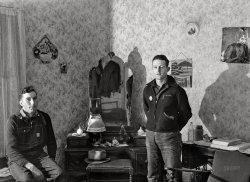
- Logan's Heroes: 1942
- ... hitchhiking along U.S. Highway 40." Acetate negative by John Vachon for the Farm Security Administration. View full size.
... I would give them a lift anytime.
(The Gallery, John Vachon, On the Road, Small Towns, WW2) ... Posted by Dave - 02/18/2022 - 2:15pm -
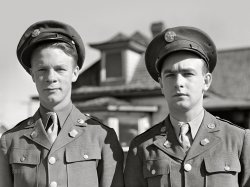
- One-Horse Town: 1943
- ... "A man going to the livestock auction." Safety negative by John Vachon for the Office of War Information. View full size.
Slice of life ... Posted by Dave - 08/21/2012 - 7:51pm -
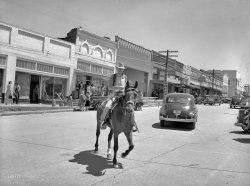
- Grizzly Gas: 1942
- ... Pennz at fifty paces. Medium format acetate negative by John Vachon for the Office of War Information. View full size.
Hope that ... Posted by Dave - 10/21/2021 - 11:10am -
![Grizzly Gas: 1942 April 1942. "Missoula, Montana. Entering the town." Grizz vs. Pennz at fifty paces. Medium format acetate negative by John Vachon for the Office of War Information. View full size.
Hope that Pennzoil sign survivedA full bell porcelain Pennzoil with the stand. Oh my ... I would die and go to heaven to have that signage. Just beautiful.
Things you can do in Missoula#1 - Buy gas.
#2 - Buy more gas.
What this town needsis a gas station.
Putting 20 cents in perspectiveAccording to a National Archives summary of 1940 Census data, average wage income in that year was $1,368. Even assuming wages had risen to $1,500 a year with the onset of the war--or roughly $29 a week--a 10-gallon fill-up for $2 would still be a nontrivial hit to your pretax pay.
Source: https://www.archives.gov/publications/prologue/2012/spring/1940.html
VehicleWhat is that bug-eyed conveyance on the highway?
[A loud Buick! - Dave]
The GrizzlymobileGas jockey drives it up and down the strip broadcasting: "Get gas at Grizzly for just 17.9 cents a gallon."
Loud Speaker CDI think it's a Civil Defense vehicle with loudspeakers.
[Or is it the Grizzly Gasoline parade car, with the company logo on each door and GRIZZLY emblazoned on each loudspeaker? - Dave]
In the more things change department ...Gas at 19 cents per gallon would be roughly $3.20 a gallon in today's dollars. Pricey!
Bluesmobile 1.0Attention, you by the gas pumps, tonight, for one night only, the fabulous Blues Brothers Revue. And it’s Ladies’ Night.
I-90 into Missoula is now BroadwayMissoula has grown and now some of the old highways are streets. I found this by getting the mountains to line up as in John Vachon's 1942 photograph. Also, if you back up the Google street view a little and swing to the left I believe the two story building with a sign in front saying, Colonial is the same two story building in the 1942 photograph with a sign in front saying, Texaco.
Grizz territoryInteresting to see the Grizzly name on the gas station. The University of Montana was founded in Missoula in 1893. Turns out the first mention of a college mascot was in 1897, when they used live bear cubs to promote their athletic teams, known as the Bears. The "Grizzlies" name was adopted in 1923.
Last GasIs that another Texaco station way down the road?
(The Gallery, Gas Stations, John Vachon, Small Towns)](https://www.shorpy.com/files/images/SHORPY-8c21976a.thumbnail.jpg)
- Belle of the Beans: 1941
- ... Our Lady of Legumes. Medium format acetate negative by John Vachon for the Farm Security Administration. View full size.
Maud ... Posted by Dave - 03/11/2020 - 7:34pm -
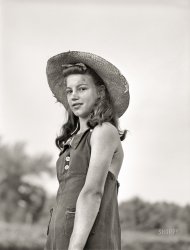
- Our Daily Bird: 1942
- ... lady and that kid . Medium format acetate negative by John Vachon for the Farm Security Administration. View full size.
Pin ... Posted by Dave - 02/16/2022 - 7:24pm -
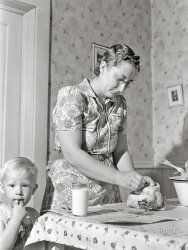
- Yellow Rows of Texas: 1943
- ... Texas. View full size. 4x5 Kodachrome transparency by John Vachon.
Hoskins Mound, Texas There is little remaining at the site of ... Posted by Dave - 08/10/2012 - 4:55pm -
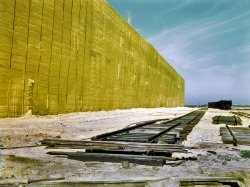
- Seven Up: 1942
- ... first post 15 years ago today, back in 2007.
John Vachon shot eight exposures of this fellow in Grand Island, Nebraska, in May ... Posted by Dave - 02/26/2022 - 1:25pm -
![Seven Up: 1942 Happy Valentine's Day from Shorpy, who made his very first post 15 years ago today, back in 2007.
John Vachon shot eight exposures of this fellow in Grand Island, Nebraska, in May 1942, and none of them has a caption, so you'll just have to use your imagination. View full size.
Time Flies and then gets blurry ...Only 15 years! Feels like at least 20 plus to me. I found the site early on, finally signed up a few years later and have enjoyed almost every post.
Dicey InspirationThat the big dice begat the idea for Giant Jenga is unlikely but the dice would be easier to tote.
Curiouser and curiouserMany years ago, as a neophyte blogger, I Googled something like, "best blogs to read" ... and a shortish list popped up that purported to comprise the absolutely essential blogs of the day. Besides Shorpy, I remember only two others: The Everywhereist, and one whose name I'd rather not mention. The only one I have visited more than once is Shorpy; I took one look and was hooked, and yes, it is essential to me. Much appreciation, Dave, for the knowledge and hours of enjoyment you have added to my life with this great work.
As for today's photo, I don't know from giant dice games but our mystery man does have a fistful of folding money. Maybe he's betting his shadow that with the right combination, the door will open. Mr. Vachon must have had some extra time on his hands.
Open open openThe early combination lock.
Thanks Dave for the past 15!
You think those dice are bigYou ought to see his windshield.
Baby needs a new pair of shoes!Love may be a crapshoot, but Shorpy is a sure thing. For me it's been 13 years 29 weeks at the Shorpy table.
Virtual MonopolyHe's trying to get to "Park Place" in a game of Virtual Monopoly?
Hang OnYou ever think that maybe the dice are normal size, and the man being shown is actually only about a foot tall? Some government experiment gone awry in Nebraska, The "Grand Island Project" or something akin?
Okay, maybe not.
My proposed captionsSweets Bayne of Grand Island, Nebraska says he wants the cops to catch him playing craps.
Sweets Bayne of Grand Island, Nebraska ordered loaded dice; didn't read the fine print.
Sweets Bayne of Grand Island, Nebraska has to stand on his money when it's his turn to roll.
A few years too early, but . . . Our mystery man looks like Richard Widmark as the horrible Tommy Udo in "Kiss of Death" (1947).
Happy Anniversary and ThanksYou can't imagine (or maybe you can) how much I enjoy Shorpy. It's my first stop every morning, and I especially enjoy visits to my current and former homes in North Carolina, Wisconsin, Pittsburgh, Maine, and Providence, and anything by Marion Post Wolcott. And along the way, I have learned a lot of history, geography, and photography.
Teneha, Timpson, Bobo, and Blair!The old Houston, East and West Texas rail line ran through Shelby County, Texas and the tiny hamlets of Teneha, Timpson, Bobo, and Blair were all stops along the line. The conductors' alliterative calls announcing the train's stops were picked up by craps shooters the same way "eighter from Decatur, the county seat of Wise" was a popular Texas-based craps call when rolling an 8.
According to lore, the craps call was diffused widely during WWII and Tex Ritter, son of nearby Panola County, had a hit song that mentioned the conductors' call.
Happy Birthday, Shorpy ... I just checked my profile and found I've been coming to this site 14 years, 17 weeks. That's a lot. Thanks Dave, Tterrace and team.
Goober Pea
Lucky Us!¡Felicidades! Happy Anniversary! And many thanks for all these years of wonderfully curated, engrossing photos.
Dice memoriesI spent nearly 40 years teaching elementary PE and I used oversized, homemade dice exactly like these regularly in all sorts of games and activities. The eight foot 4x4 i chopped up way back when was a super investment. I sure miss being around those kids. They kept me young.
And a slightly belated Happy Anniversary to Shorpy and the whole crew that makes it such an interesting and essential daily stop for me. Here's to 15 more!
Shorpy was built on more than a roll of the dice.As my father used to say while shooting dice, "Papa needs a new pair of shoes!"
Adding my thanks to Dave for setting up and running Shorpy. Without Dave’s wit, knowledge, and wisdom, it would be just another “vintage photos” site. To those who have ever said or done something dumb and felt the slash of Dave’s quirt of wrath, stand proud. You have earned the right to wear Shorpy’s bloodied but unbowed, golden badge of honor. Combining all elements, Shorpy is an outstanding site that keeps people coming back for more. Thanks very much Dave, colleagues and contributors and Happy Birthday Shorpy!
[Aw shucks. Also: The "role" of the dice is to roll. - Dave]
Ha! Ya got me Dave - putting on my golden badge. Role/roll now corrected.
FloatingMy first thought was "Guys and Dolls" ...
Happy anniversary!Wishing you happines and joy from running shorpy.
Best regards.
Javier
Happy belated anniversary!I look forward, every evening, to the Shorpy post! For me, going on 7 years. Essentially, a time machine to look back at interesting times. I’ve learned so much from Shorpy in these 7 years. Thank you Dave for a wonderful daily stop for all of us!
Shorpy's tenthTo celebrate Shorpy’s fifteenth birthday, I went back to the post that celebrated the tenth birthday. I invite you all to go visit and read the comments from back then. Amidst all the nostalgia of revisiting half a decade ago, I must confess to a feeling of sadness at reading the names of commenters who no longer appear.
Hooked on ShorpyI don't know if I have been a fan of the Shorpy site for 15 years but I have sure been a fan for a long time. Best Wishes to both the administrators and the other fans of Shorpy. I hope you have, at least, another 15 years of success.
Always a day lateAnd $1.36 short (inflation adjusted). Happy Birthday Shorpy, Ken, Dave, tterrace and all of us! Shorpy remains sui generis!
Thanks CommishBobI hope it's OK to say a thank you to CommishBob for what he posted to this thread. His post touched me, and I just want to thank you Commish for devoting your career to the youngsters. They no doubt loved you.
Thanks for the Memories ... :)Dave, Thanks for all the wonderful pics you have enlightened us with over these 15 years ... And then there's your wit too. HAHA.
(The Gallery, Bizarre, John Vachon, Slender Man)](https://www.shorpy.com/files/images/SHORPY-8c22090a.thumbnail.jpg)
- The Last Roundup: 1941
- ... Austin, Minnesota." Medium format acetate negative by John Vachon for the Farm Security Administration. View full size.
Shocking! ... Posted by Dave - 04/04/2020 - 3:13pm -
![The Last Roundup: 1941 July 1941. "Heads of beef cattle. Hormel meat-packing plant, Austin, Minnesota." Medium format acetate negative by John Vachon for the Farm Security Administration. View full size.
Shocking!I love a Big Mac and a great steak as much as the next guy. But, this was a tad shocking and traumatic to see. Wish I could "Un-see" it.
["Shocking and traumatic for YOU??" -- The Cattle]
DecowpitatedThere are SOOOOO many barbacoa tacos just waiting to be cooked, right there!
Where Do Slim Jims Come From?I think I may be getting closer to solving this riddle.
At first glanceI thought it was a circus carousel melted after a fire. Scary.
YOU LOOKIN AT ME?!It would be far less spooky if the eyeballs were not still in the heads.
Can't unsee thisAnd I wish I could. It's very sad.
Prettier with a sunflower.Which one is Elsie?
Just a hunch. My guess is this particular photo will not be popping up again in colorized form.
WOW, I really don't know what to say about this one.This is one of the uhhhh, most difficult?, more powerful?, more unusual? images I have seen on Shorpy in 10 years or so. John Vachon really left us some amazing photography. I've become a big fan of his because of what I've seen on Shorpy. I wish there was a large format book of his work.
It's what's for lunchHead cheese*. Usually made from a pig's head, but cows are used as well. Head cheese sandwiches were a regular item in my brown bag school lunches, probably because it was cheap. I wonder if it is still available?
*A meat jelly cold cut made with flesh from the head of a calf or pig, or less commonly a sheep or cow, and often set in aspic.
Respecting the law and enjoying sausage.Sometimes blissful ignorance is the best route.
Colorized VersionI don't really know what the colors should really be, but here is my version.
(The Gallery, Bizarre, Animals, Factories, John Vachon)](https://www.shorpy.com/files/images/SHORPY-8c19728a.thumbnail.jpg)
- Mudville, Montana: 1942
- ... Fort Peck construction era, now nearly deserted." Photo by John Vachon for the Office of War Information. View full size.
WPA ... Posted by Dave - 11/24/2021 - 11:22am -
![Mudville, Montana: 1942 March 1942. "Wheeler, Montana. Boom town of the Fort Peck construction era, now nearly deserted." Photo by John Vachon for the Office of War Information. View full size.
WPA dambuilding projectWikipedia has a bit on Fort Peck: https://en.wikipedia.org/wiki/Fort_Peck,_Montana
Originally an Indian trading post, in the 1930s this was a WPA project to build a dam, some structures remain.
[The dam was also on the cover of the first issue of Life magazine. - Dave]
Four Peck Dam photo by Margaret Bourke-WhitePerhaps the most recognizable photographs involving Bourke-White show her perched on a Chrysler Building gargoyle. Ironically, she is the subject, not the photographer, of those famous photos. Oscar Graubner, described online as Bourke-White's darkroom assistant, took the photos.
Mud seasonThe dreaded springtime thaw!
With apologies to Ernest Lawrence ThayerThere is no joy in Mudville.
There's no joy… being in that parking area.
Hot shotOne of Margaret Bourke White's most famous photographs.
(The Gallery, Frontier Life, John Vachon)](https://www.shorpy.com/files/images/SHORPY-8c21418a.thumbnail.jpg)
- Flag Day: 1941
- ... Pennsylvania." Medium format acetate negative by John Vachon for the Farm Security Administration. View full size.
... stars both staggered and gridded. - Dave]
Kudos John Vachon was a great talent. What an incredible picture!
Timeless window ... Posted by Dave - 09/04/2020 - 3:36pm -
![Flag Day: 1941 June 1941. "Flag Day. Pittsburgh, Pennsylvania." Medium format acetate negative by John Vachon for the Farm Security Administration. View full size.
Paraphrasing Justice Potter StewartI shall not attempt further to define a great photograph ... but I know one when I see one.
This is a great photo.
Flag questionShouldn't the stars on the flag from 1941 be in a 6x8 grid, not offset rows as shown in the photo?
[The 1912 executive order pertaining to 48-star flags specifies only that the stars be in six rows of eight stars each, "symmetrically arranged." And of course the flag makers could arrange the stars however they wanted. There are (or were) countless examples of flags with stars both staggered and gridded. - Dave]
KudosJohn Vachon was a great talent. What an incredible picture!
Timeless window screenI am reminded of all the places I've lived where I had one of those screens to insert in the window opening. They're still around. Would keep out the flies, but wouldn't be effective against the smoke from those mills.
Fly the flag!And step out for a breath of fresh air.
Flag --Looks like the US flag for 1890-1891 - 43 stars. Probably flew what he had.
[This flag has 48 stars. - Dave]
(The Gallery, Factories, John Vachon, Patriotic, Pittsburgh)](https://www.shorpy.com/files/images/SHORPY-8c19359a.thumbnail.jpg)
- Des Moines: 1940
- ... Iowa." View full size. 35mm nitrate negative by John Vachon for the Farm Security Administration.
All Together Now Now all ... Posted by Dave - 05/29/2008 - 1:10am -
![Des Moines: 1940 May 1940. "Afternoon, downtown Des Moines, Iowa." View full size. 35mm nitrate negative by John Vachon for the Farm Security Administration.
All Together NowNow all together, put your right foot forward. Hmnnn, how did Busby Berkeley, I mean John Vachon ever get all them folks to synchronize like that, now that's a photographer.
Des MoinesDoes anyone know where in Des Moines this is? I'm sure it's downtown. I tried to search for Hotel Franklin, but came up with nothing.
[The Hotel Franklin was at Fifth and Locust. - Dave]
Hotel FranklinThe image is looking north on 5th Avenue at Locust. One can tell the direction and street by the bend in the road in the near distance. In the downtown area, only streets on the north edge (mostly numbered streets) bend that way.
The Franklin Hotel became a rat trap by the '70s and was torn down toward the end of that decade or in the 1980s.
The people look reasonably well-dressed, but so thin -- almost gaunt in some cases. Busby Berkeley indeed.
(The Gallery, John Vachon)](https://www.shorpy.com/files/images/8a06255u.thumbnail.jpg)
- The Merry Strikers: 1938
- ... hourly wage of 17 to 20 cents." Medium format negative by John Vachon. View full size.
World's most contented strikers ... Posted by Dave - 02/27/2013 - 1:05pm -
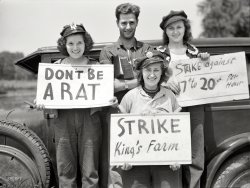
- Baby Barkhoefer: 1942
- ... Barkhoefer and family." Medium format acetate negative by John Vachon for the Office of War Information. View full size.
The Tree of ... Posted by Dave - 10/22/2021 - 12:37pm -
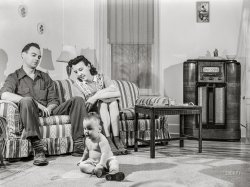
- The Farmer's Wife
- ... Oskaloosa, Kansas. View full size. Photograph by John Vachon.
Mom Wow. She looks so young...
Yeah! That was my first ... Posted by Dave - 09/08/2011 - 12:55pm -
![The Farmer's Wife October 1938. Farm wife and baby waiting in the car while her husband attends the auction. Oskaloosa, Kansas. View full size. Photograph by John Vachon.
MomWow. She looks so young...
Yeah!That was my first thought as well! Like she's 16 or something.
The kidI'm surprised nobody commented on the baby playing with his new iBook! I didn't even know Apple made laptops back then!
Candid shotsI wish I could get these great candid shots. It's amazing they could do it with the big bulky cameras of the day.
[Actually this one was taken with a smallish 35mm camera, probably a Leica. - Dave]
Ford or Chevy?I think it’s a Ford Model A, based upon the location of the side rearview mirror, rain gutter over the door and the way the roof slopes down to meet the windscreen. Or maybe not. And yep: she's pretty.
Denny Gill
Chugiak, Alaska
Ford Model A?This is a truck, right? There's no back seat or second window.
It's a Ford all rightBut I think it's a AA truck. You can see the stake bed through the window.
HometownI grew up in Oskaloosa. This picture makes me extremely nostalgic, even with the knowledge that these were very hard times.
(The Gallery, Cars, Trucks, Buses, Great Depression, John Vachon, On the Road)](https://www.shorpy.com/files/images/8a03785u.thumbnail.jpg)
- Ah, Wilderness: 1953
- ... her ankle filming River of No Return . Photo by John Vachon for Look magazine. View full size.
Mountains What mountains? ... Posted by Dave - 07/11/2013 - 3:40pm -
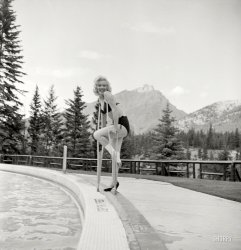
- Big Cop: 1938
- ... "Policeman, Lincoln, Nebraska." 35mm nitrate negative by John Vachon for the Resettlement Administration. View full size.
The Addams ... Posted by Dave - 09/29/2010 - 8:49pm -
![Big Cop: 1938 October 1938. "Policeman, Lincoln, Nebraska." 35mm nitrate negative by John Vachon for the Resettlement Administration. View full size.
The Addams FamilyUncle Fester on patrol.
Negative, I know ...But he looks like a lot of present day and women on the street just coming out of McDonald's. You don't see as many people this large prior to about 1950 or 60. That's one large man judging by his head and back! Whoa!
They don't wear hats anymoreRemember when cops wore hats? In some cities it was required that they wore their hat when dealing with the public. Nowadays, it's no hat, a buzzcut or a shaved head, and wraparound shades.
Next frame: death stare.I wonder if the clicking noise made him turn around.
I'm sure of one thingThis cop would never have needed to use a taser, even if he had one.
Now I get itMy son once described the back of my head and neck as "looking like a package of hot dogs". Although this officer's is not quite that extreme, I can now see what he meant.
Tor JohnsonHis day job.
Nick on O StreetThat would be Officer Nick Nichols, at 11th & O streets, looking west, doing what was known as "O Street time"--standing on Lincoln's main street in the downtown business district, not so much to direct traffic as to portray a visible police presence. Gold's department store on the SW corner to his left is easily identified today, as is City Hall--the former Post Office and Federal courthouse, also extant today, and still under municipal care a block further west on the north side between 10th and 9th. I would peg this photo as about 1942.
[As noted in the caption, the picture was taken in October 1938. Below, more of John Vachon's Lincoln photos, including the officer's other side. - Dave]
Inspires respectA look back at the good old days when they hired police officers whose mere size and presence inspired respect.
I doubt many young punks disrespected this officer to his face like they do nowadays.
I love this photoI know nothing about the photographer, John Vachon, but this shot made me take a look at his work here Shorpy, and I'm glad I did. My favorites (like this one) seem to have this something casual or playful about them, while still being formally well-composed.
(The Gallery, John Vachon)](https://www.shorpy.com/files/images/8a03729a.thumbnail.jpg)
- The Banana Wagon: 1943
- ... on Franklin Street." 4x5 inch Kodachrome transparency by John Vachon. View full size.
What a house- hasn't seen a What a ... Posted by Dave - 04/29/2017 - 11:48am -
![The Banana Wagon: 1943 2017 UPDATE: The man is fruit vendor Abe Cweren, who came to America from Poland in 1922. (Originally posted in 2007.)
May 1943. Houston, Texas. "Old house with fruit stand on Franklin Street." 4x5 inch Kodachrome transparency by John Vachon. View full size.
What a house- hasn't seen aWhat a house- hasn't seen a coat of paint in years! Look at the attic window covered with an old sign.
Thank heaven for the FSANow you're starting to post some of my personal favorites! I posted an article on FSA photography last summer, the subject never strays far from my heart! Thanks for a great site.
Here's what I had to say on the subject.
Does anybody know why theDoes anybody know why the color in these old photos looks so good?
I love the "painted" quality of the colors. Wish I could reproduce this effect in photoshop with my digital camera.
ColorThese are scanned from 4x5 inch Kodachrome transparencies and then color-corrected. It's hard to do better than large-format Kodachromes taken by a professional photographer. Digital has yet to equal that combination.
What House?It seems to be all adornment and very little living space. That's the oddest Victorian I've ever seen.
Color quality1 word answer: Kodachrome
Banana Wagon/HouseI remember this place...and thought it was Houston for sure when I saw the mosaic street name and block number on the curb (far right). There are still several of these mosaic street markers left that haven't been destroyed by road construction.
Attic WindowCan anyone comment on the odd 3rd floor window? It's as if some picture has been pasted in over the original.
[Covered with tin signs. - Dave]
Modeling help?Does anyone have any other angles of this wonderful structure, since it no longer stands? I would love to try and model this structure. Thanks Pat
White OutEven Kodachrome shows the Houston summer sky as being white, not blue or gray. I've tried to explain this to people who've never lived there, and they find it hard to believe that it could be sunny and white-skied. My rejoinder is "Head there in August."
Fredericks HouseThe earliest owner of this house I have been able to find is Gus Fredericks, the owner of a jewelry store, as listed in the U.S. Census of 1900. His wife was Lottie and they had three children: John, Pierce, and Julia. His sister Louise Wagner and her daughter Lilian were also living there along with another nephew Gus B. Fredericks.
I believe the correct address is 1902 Franklin Avenue. The curb sign for 1900 Franklin Street identifies the block in Houston. The layout of the house on the property at 1902 Franklin Ave., shown below, matches the photo shown in this Shorpy image.
This picture below is from the 1907 Sanborn Map of Houston, Volume 1, Sheet 11. The link to the original picture is below. If you click on the image that opens it will magnify the picture. There was another smaller house here that this one replaced sometime between 1896 and 1907. The address was originally 242 Franklin on earlier Sanborn Maps.
http://www.lib.utexas.edu/maps/sanborn/g-i/txu-sanborn-houston-1907-vol1...
The property was approximately 80' X 100' and was on the Southeast (South directionally) corner of Franklin (a brick street) and Hamilton (a gravel street). It was just a block from Firehouse Number 10 which had 7 men, 4 horses, one hose wagon, one steamer, and 2000' of hose. There was a stable at the back of the Fredericks property.
The circular turret on the third floor is interesting because it does not look like there is any way to enter it. The Sanborn drawing shows the house as two floors, so perhaps the entire third floor is just a crawl space or attic area.
In 1940, Rudolph Martinez was living here with his wife, Candalanca, and son Rudolph Jr. Living with them were Rudolph's sister Isabell Samora and her two children, Raymond and Joe Louis. Rudolph was 30 years old and a chef at a night club. Perhaps that's Rudolph behind the fruit cart in the street.
Turret to NowhereI'm going to theorize the porches and Victorian doodads were added later to a simple, pre-existing structure. I can't imagine anyone designing a house with that "turret to nowhere" from scratch; it simply stops at the porchline. It's begging to be extended down the whole height of the house.
The view todayJust a bit different. I-59/69 to the left, Minute Maid Stadium on the right. The property at Hamilton & Franklin long since becoming a parking lot.
Abe Cweren, fruit dealer. In the picture is likely Abe Cweren. He wrote on his wagon "Jockey Cweren -- Kentucky Derby." He came from Poland in 1922 and was a fruit peddler. He had two sons and they went on to have a very successful business, Greater Houston Iron & Metal Company. I sent the photo along to his grandchildren in case they'd never seen it.
Granddaughter of PeddlerMy late father always talked about his father, Abe Cweren, and his horse and wagon on Franklin Street. I was so excited to see this part of my family history. My dad's portrayal came to life. Wish there were more.
Shout-out to the nice lady who took the time to find me and send me this photo. I am beyond thrilled to have this piece of history to show my four children.
(The Gallery, Kodachromes, Horses, John Vachon, Stores & Markets)](https://www.shorpy.com/files/images/SHORPY-1a35441u2.thumbnail.jpg)
- Milwaukee Yards: 1941
- ... Milwaukee, Wisconsin." Medium format acetate negative by John Vachon for the Farm Security Administration. View full size.
Precious ... Posted by Dave - 03/22/2020 - 12:44pm -
























